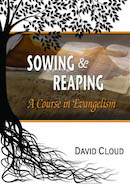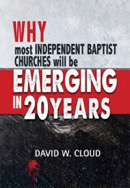866-295-4143, fbns@wayoflife.org
It has been said that “a picture is worth a thousand words,” and I have no doubt that more people have been influenced to believe in evolution by artwork than by words. From its inception, Darwinian evolution has been popularized by art - lying art.

"Lucy"
The premier missing link between apes and men today is Australopithecus afarensis, a little creature that has been popularized by giving one set of fossils the endearing name of “Lucy.”
Artistic reconstructions typically depict Lucy with human hands, walking uprightly in a purely human manner on human feet, and typically with human-proportion arms and legs. This is true for the models and drawings that I have seen personally at the Museum of Natural History in New York City, the American Museum of Natural Sciences in Washington D.C., the Field Museum in Chicago, Yale University’s Peabody Museum, the Seattle Science Center, the Museum of Man in San Diego, and Michigan State University Ann Arbor.
You can also find drawings of Lucy in science textbooks that depict her walking uprightly with human hands and feet. An example is Life: The Science of Biology by Purves, Orians, and Heller, 1992, p. 604.
These reconstructions are not scientific; they are brainwashing tools.
It is known from the fossil evidence that Lucy had an ape’s head, an ape’s hands, an ape’s arms, an ape’s legs, and an ape’s feet. While some paleoanthropologists claim that Lucy walked upright, others dispute this, and it is probable that the creature walked upright only in an apelike fashion.
In 1976, Charles Oxnard, professor of anatomy and human biology and a leading expert on australopithecine fossils, wrote that the pelvis and ankle bone of Australopithecus indicate that it “was far from being able to walk upright in the human sense. ... it is very unlikely that Australopithecus occupied a position on the evolutionary line leading to man” (Scientific American, Feb. 1976).
In 1982, Bill Jungers at the Stony Brook Institute in New York “argued that Lucy’s legs were too short, in relation to her arms, for her species to have achieved a fully modern adaptation to bipedalism” (Lucy’s Child, p. 194).
In 1983, Randy Susman and Jack Stern, also of Stony Brook, concluded that Lucy and her kin spent most of their time climbing trees. They “detailed more than two dozen separate anatomical trait suggesting that the species was a less efficient biped than modern humans” (Lucy’s Child, p. 194). They described Lucy’s hands and feet as being long and curved, typical of a tree-dwelling ape, even more highly curved than a chimpanzee (Milton, Shattering the Myths, p. 207).
That year Susman and Sterm reported in the American Journal of Physical Anthropology:
“The fact that the anterior portion of the iliac blade faces laterally in humans but not in chimpanzees is obvious. The marked resemblance of AL 288-1 [Lucy] to the chimpanzee is equally obvious” (J. T. Stern and R. L. Susman, American Journal of Physical Anthropology, 80:279, 1983).
Russell Tuttle of the University of Chicago reached the same conclusion as Jungers, Susman, and Sterm. He pointed to the “curved fingers and toes” as an “apelike adaptation for grasping tree branches.”
In 1983, a conference was held at the Institute of Human Origins at Berkeley to discuss the issue of Lucy’s bipedalism. Russell Tuttle argued that the Laetoli footprints could not have been by Lucy-type creature because its long, curved toes and other features would have left a different sort of print (Lucy’s Child, p. 196). Randy Susman emphasized that the creature’s “strong, curved, apelike finger bones,” and its “long arms relative to its legs” speak of tree living. Jack Stern used features of the hip, knee, ankle, and pelvis as evidence for his view that the creature did not walk in a human fashion.
In 1987, Oxnard did an extensive computer analysis of the existing bones of the Australopithecus and concluded that it walked like an ape, not a man.
In 1993, Christine Tardieu, an anthropologist in Paris, reported that Lucy’s “locking mechanism was not developed.” Humans have a locking mechanism in our knees that allow us to stand upright comfortably for long periods of time. Lucy didn’t have that, so she certainly didn’t stand around nonchalantly like she is depicted in the museums.
In 1994, J.T. Stern, Jr., told the 63rd Annual Meeting of the American Association of Physical Anthropologists that he believes that A. afarensis “walked funny, not like humans” (Gish, p. 257).
The Journal of Human Evolution reported that a biochemical study of the hip and thigh of the Australopithecus had concluded that it did not walk uprightly (Christine Berge, Journal Human Evolution, 1994, pp. 259-273).
In 1995, Science News reported that a partial skeleton of an A. africanus had been found “whose ‘apelike’ body was capable of only limited two-legged walking” (Gish, p. 257). This was found in Sterkfontein, where the original Australopithecus africanus was discovered. The pelvis was “generally ape-like in shape.”
In 2000, Nature magazine reported, “Regardless of the status of Lucy’s knee joint, new evidence has come forth that Lucy has the morphology of a knuckle-walker” (Richmand and Strait, “Evidence that Humans Evolved from Knuckle-Walking Ancestor”).
In 2009, anthropologists gathered at the Institute of Human Origins in New York to discuss Lucy, and a report in the New York Times had the following interesting conclusion: “The debate over whether the primate Lucy actually stood up on two feet three million years ago and walked--thus becoming one of mankind’s most important ancestors--has evolved into two interpretive viewpoints, three family trees, spats over four scientific techniques and too many personality clashes to count. ... The long and short of it is, according to a participant, that BIPEDALITY LIES IN THE EYE OF THE BEHOLDER” (“Did Lucy Actually Stand on Her Own Two Feet?” New York Times, Aug. 29, 2009).
Thus, there is no consensus even among evolutionists that Lucy walked uprightly, and there is strong evidence that she did not. It is probable that she walked on all fours like an ape, while walking upright for short distances. One day in Kathmandu in 2008, I saw a rhesus macaque monkey walk a long distance on his back legs. Apes can walk upright, but they aren’t designed to do it comfortably and naturally like a man does.
Sadly, the aforementioned lying evolutionary artwork is used to educate children. For example, at its website, San Diego’s Museum of Man says that it is targeting “audiences of sixth and seventh graders in 500 schools county-wide.”
But this is not education; it is propaganda.
Dr. David Menton complained to the St. Louis Zoo about their Lucy exhibit, but his protests were rebuffed. Menton, who has a Ph.D. in cell biology from Brown University, said, “I think the zoo owes it to all the people who helped pay for that exhibit to give (Lucy) an honest presentation.” But Bruce Carr, the zoo’s director of education, said they had no plans to change the exhibit. “What we look at is the overall exhibit and the impression it creates. We think that the overall impression this exhibit creates is correct” (Creation Ex Nihilo, Volume 19 Number 1, Dec 1996 - Feb. 1997).
This is a powerful admission. The “impression” that the Lucy model creates is that Australopithecus was an ape-man, a creature that had some ape-like features but walked erect like a man and had human hands and feet. It is a false impression that is contradicted by the evidence, but it is exactly the impression that they intend to give.
- Receive these reports by email
- www.wayoflife.org
______________________
Sharing Policy: Much of our material is available for free, such as the hundreds of articles at the Way of Life web site. Other items we sell to help fund our expensive literature and foreign church planting ministries. Way of Life's content falls into two categories: sharable and non-sharable. Things that we encourage you to share include the audio sermons, O Timothy magazine, FBIS articles, and the free eVideos and free eBooks. You are welcome to make copies of these at your own expense and share them with friends and family. You may also post parts of reports and/or entire reports to websites, blogs, etc as long as you give proper credit (citation). A link to the original report is very much appreciated as the reports are frequently updated and/or expanded. Things we do not want copied and distributed are "Store" items like the Fundamental Baptist Digital Library, print editions of our books, electronic editions of the books that we sell, the videos that we sell, etc. The items have taken years to produce at enormous expense in time and money, and we use the income from sales to help fund the ministry. We trust that your Christian honesty will preserve the integrity of this policy. "For the scripture saith, Thou shalt not muzzle the ox that treadeth out the corn. And, The labourer is worthy of his reward" (1 Timothy 5:18). Questions? support@wayoflife.org
Goal:Distributed by Way of Life Literature Inc., the Fundamental Baptist Information Service is an e-mail posting for Bible-believing Christians. Established in 1974, Way of Life Literature is a fundamental Baptist preaching and publishing ministry based in Bethel Baptist Church, London, Ontario, of which Wilbert Unger is the founding Pastor. Brother Cloud lives in South Asia where he has been a church planting missionary since 1979. Our primary goal with the FBIS is to provide material to assist preachers in the edification and protection of the churches.
Offering: Offerings are welcome if you care to make one. If you have been helped and/or blessed by our material offerings can be mailed or made online with with Visa, Mastercard, Discover, or Paypal. For information see: www.wayoflife.org/about/makeanoffering.html.





